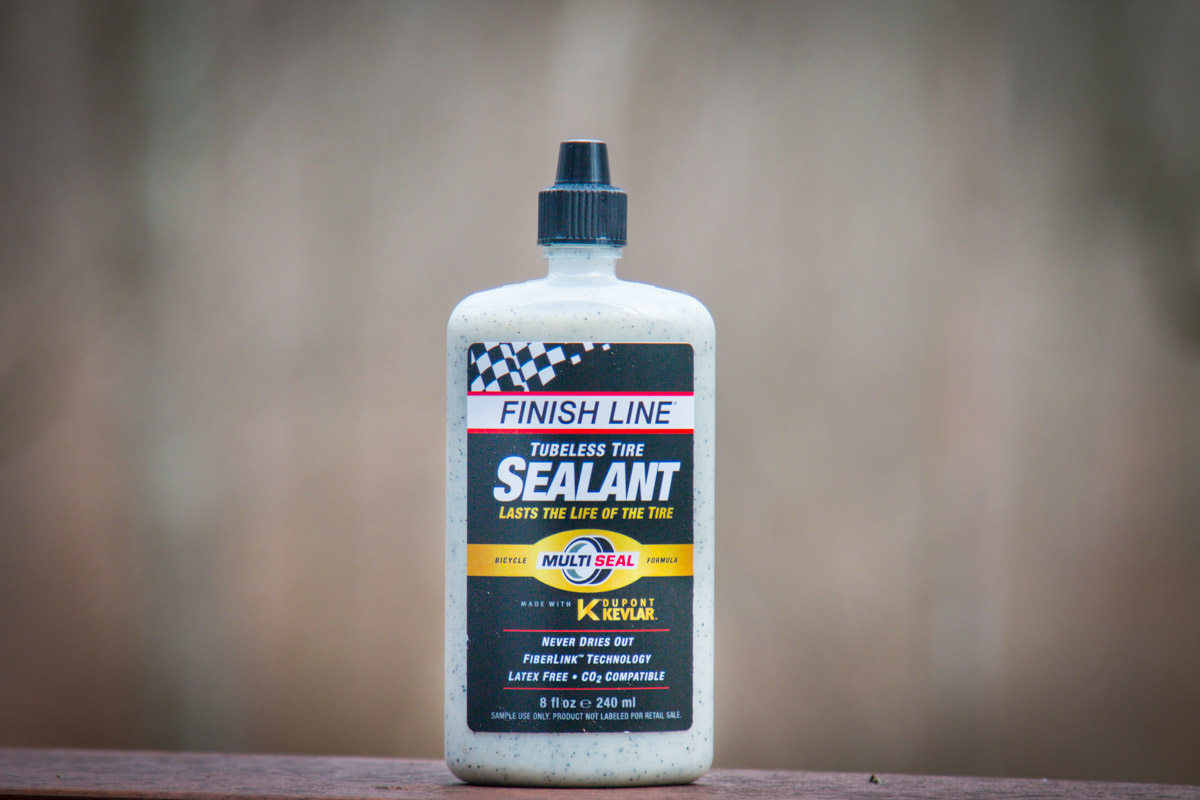If you haven’t seen it by now, Finish Line has a new tubeless tire sealant. Far from just another tire sealant, Finish Line claims that theirs is revolutionary. Why? They say it will never dry out, it will last the life of your tire, and it cleans up easily with water among other benefits.
While the press release offered the basic details, we thought that this product was worthy of a more in depth look.
Bikerumor: Why hasn’t anyone done this with a sealant before? Or maybe it should be framed as, what were the biggest hurdles to overcome in creating a long lasting sealant?
Dave Vollbach, Finish Line Marketing Manager: To be frank, Latex sealants work well and have been accepted as an industry standard for a long time. Many users of latex sealants, however, are well aware of latex’ short comings. Developing a non-latex formulation that uses fibers was challenging. The most significant challenge was choosing the type of fibers (we use 5 different types) and the length, shape and diameter of those fibers- these are all specifications that we control. The second challenge was finding a way to keep these fibers, each with different densities, suspended in a carrier. If there was separation in the bottle or inside the tire, the sealant would not work.
Bikerumor: You mention you worked with Multi-Seal – is this a new formulation specifically for Finish Line, or a previous formula used in other industries?
Finish Line: Finish Line has enjoyed an almost 30 year working relationship with DuPont. Our founder, Hank Krause, works closely with scientists and engineers at Dupont’s Research Center in Wilmington, Delaware. When we started our work using Dupont Kevlar® fibers, Dupont suggested that we consult with Multi Seal, who was already using Kevlar® in industrial and military tire sealants. Our collaboration with Multi Seal led to a bicycle-specific formulation that is both extraordinary and much different than the sealants used in their heavy-duty industrial tires.
Bikerumor: What causes some sealants to weep through the sidewall of certain tires? Will that happen with Finish Line?
Finish Line: Two part answer: 1. When a new tire is installed using latex, it is common for the latex to spit and splatter through the bead when inflated and spun. This creates a bit of a mess and leads to the loss of some sealant. Finish Line’s fiber technology dramatically reduces and even eliminates this phenomena. 2: Some tires, especially some of higher end ones, have exceptionally thin sidewalls. And of course rubber is porous. Over time, small amounts of sealant, latex and ours, will soak into the rubber, and to this extent, this help reduce loss of air due to rubber porosity. Our testing shows that tires treated with our sealant lose less air over time than do latex treated tires. We are not sure if this is due to tighter seals around the beads, or less loss of air through the rubber.
Bikerumor: Does Finish Line sealant need to be installed in a new tire? Will it react with other sealants?
Finish Line: We definitely do not recommend mixing sealants. Since our sealant works via a fundamentally different mechanism than latex sealants, mixing our sealant with any other sealant will reduce effectiveness. Therefore, when converting from a latex sealant to Finish Line, it is important to remove as much of the old as possible.
Bikerumor: Can you transfer Finish Line sealant from one tire to another? Say if you wanted to change tires for conditions?
Finish Line: Since our sealant will last the useful life of the tire, it can be re-used or transferred from one tire to another. That said, because of the absorption noted above and a general inability to transfer every last bit of the sealant, we would recommend adding a bit more sealant to the new tire.
Bikerumor: If it can be used to -10°F, it seems like a good candidate for many fat bike users – what amount of sealant would you recommend for 4″ tires? 5″ tires?
Finish Line: We would recommend 6-8oz in a 4” tire and at least 8oz in a 5” tire. I would say that if an end user is in doubt about dosage, adding a little more for safety won’t be a problem. I should also note that while our sealant won’t freeze down to -10º F, it will flow more slowly as the temperature drops well below freezing. It will still work, but because of the reduced flow rate punctures may take a few extra seconds to seal.
Bikerumor: Can Finish Line Sealant be installed through the valves? Or is it best to open the tire up and dump it in?
Finish Line: Finish Line Sealant can definitely go through valves, and our tip actually fits perfectly over a presta valve when you snip it off about halfway down (This is on directions of label). As an additional bonus, since our sealant isn’t an adhesive, your valve cores won’t get gunked up/clogged like they always do with other sealants. If you’ve ever tried to pump up a tire that had sealant installed through the valve stem months before, you know what I’m talking about.
*updated at 12:30 EST with more info from Finish Line
